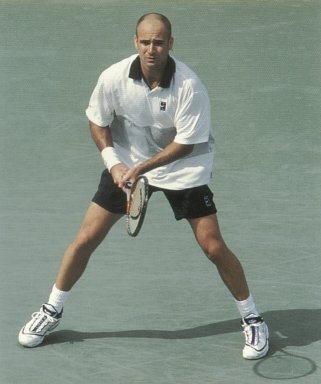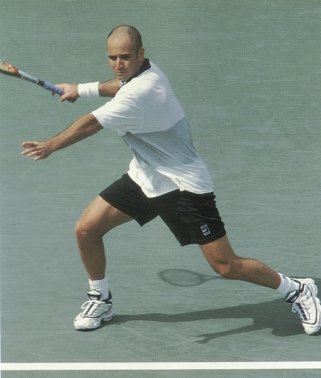The Forehand Return of Serve







* Both players are in the process of landing from their split step. Agassi’s upper body is learning slightly forward, whereas Kuerten is more upright in posture. They have a wide stance with a low center of gravity, and their knees are bent. They are using forehnad grips. Note that, based on where they are standing, Agassi is returning a first serve and Kuerten a second serve.
* Both players have started their unit turn and their initial racquet preparation. Their right foot has turned out, in the direction they are about to move. As they are turning their upper body, their left arm comes across the body, which facilitates the turn of the front shoulder and helps store energy in the shoulder and back muscles. This arm movement is a key to early preparation.
* Both players are getting into the full loaded position in which they are storing energy in their large muscle groups. Their quick move into the fully loaded position allows them to take a short backswing to reach that position, from which they can readily handle and generate power. Both have a reletively small loop in their backswing. The turning of their upper body accounts for much of the racket preparation to this point. Both players have good body posture. Note that Agassi has a much more pronounced turn and a lower center of gravity.
* Both players have excellent posture and balance. They take a short backswing and are positioning themselves for contracting the ball in the optimum location in relation to their body. Note that Agassi has one of the most compact backswings in the game. The fact that he gets a great “load” in the early preparation phase enables him to deal with and generate power with such a short backswing.
* Both players display excellent dynamic balance even though they are off the ground. They have their head up and focused on the point of contact. Notice how both players have exploded up and into the shot with their back leg. This propels them off the ground and transfers their weight forward, into the court. Note how little the head has moved just after contact.
* The tremendous angular momentum ( rotation) and racket acceleration is evident. Notice how significantly their body has uncoiled and how quickly the racket arm has pronated, resulting in a follow-through finishing low and to the side of the body. Both players continue to maintain excellent dynamic balance.
* The racket continues to wrap around the body as each player finishes the stroke. From this point, the player will immediately go into the recovery stage and prepare for the next shot.







